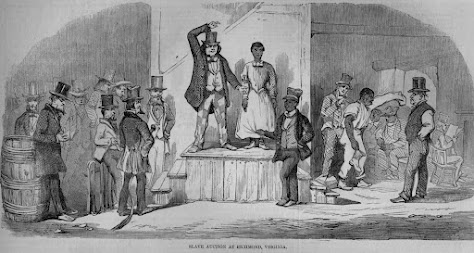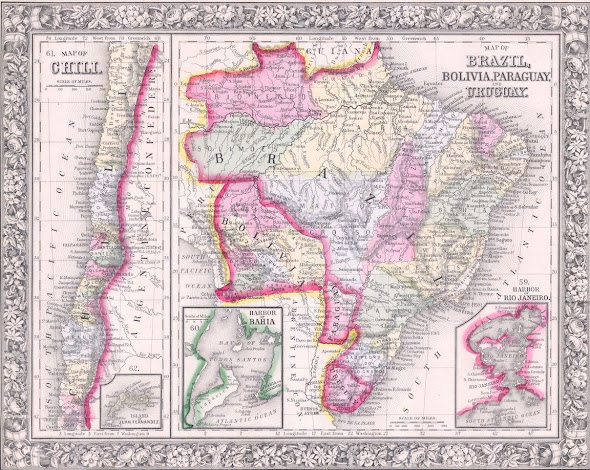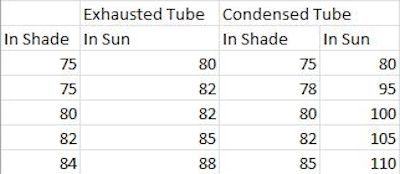1859 Largest Slave auction in History--Savannah, GA
Slave Auction 1853-- Richmond, VA
By 1859 Pierce Butler was no longer America's richest man. At age 52, he had squandered the fortune inherited from his grandfather. Following the spectacle of his very public and very expensive divorce from English actress Fanny Kemble in 1849, gambling, and "bad investments," Butler declared bankruptcy in 1857. His bankruptcy administrators forced the immediate sale of his magnificent mansion in Philadelphia for $30,000.
Now, all that was left to sell were the 436 human beings he held in slavery on two plantations in Georgia.
It would be the largest slave auction ever held in America.
Jonathan Bryan, a notorious slave dealer, was hired to run the auction. Bryan printed a catalogue of the "goods to be auctioned" much as an auction house might publish a catalogue, listing paintings, jewelry or furniture to be auctioned. After sending out the catalogue and advertising in newspapers, Bryan expected over 200 buyers to show up March 2 and March 3, 1859 at a rented racehorse stable three miles outside Savannah, Georgia.
Now, all that was left to sell were the 436 human beings he held in slavery on two plantations in Georgia.
It would be the largest slave auction ever held in America.
Jonathan Bryan, a notorious slave dealer, was hired to run the auction. Bryan printed a catalogue of the "goods to be auctioned" much as an auction house might publish a catalogue, listing paintings, jewelry or furniture to be auctioned. After sending out the catalogue and advertising in newspapers, Bryan expected over 200 buyers to show up March 2 and March 3, 1859 at a rented racehorse stable three miles outside Savannah, Georgia.
It took time
and money to transport the slaves to Savannah. Horse stables were Bryan’s
solution to housing so many people until auction day. Entire families spent
several weeks in horse stalls before being gathered together when the auction began. Bryan wanted to make sure the "goods" were in top condition. Evidently, he provided adequate food and sanitation because only seven slaves were
ill or infirm as of the auction date.
Some dealers showed up several days early to look through the stables, cross referencing stable numbers with the people's bid lot numbers.
Some dealers showed up several days early to look through the stables, cross referencing stable numbers with the people's bid lot numbers.
Butler and
Bryan insisted there would be no sales breaking up families. This sounds
humane. The slaves were apprehensive about the process and leaving the home plantation. Butler had not bought any slaves. Few, if any, of Butler's slaves had ever been sold. By promising to keep families together there was less resistance by the slaves to being taken away to new owners.
Surely, Butler and Bryan knew professional slave dealers would buy entire families and then resell them with no regard to keeping children with parents or keeping married couples together almost as soon as they left the auction area.
Shortly before the auction began, Pierce Butler circulated through the stables, giving each of his chattels a silver dollar. "His people" were so brain washed, so unaware of a wider world, they reacted as if a great, benevolent, unexpected god had appeared before them. One declared he could "die happy now having seen the master."
Surely, Butler and Bryan knew professional slave dealers would buy entire families and then resell them with no regard to keeping children with parents or keeping married couples together almost as soon as they left the auction area.
Shortly before the auction began, Pierce Butler circulated through the stables, giving each of his chattels a silver dollar. "His people" were so brain washed, so unaware of a wider world, they reacted as if a great, benevolent, unexpected god had appeared before them. One declared he could "die happy now having seen the master."
The morning of March 3, heavy rain and lack of transportation delayed the auction several hours. Meanwhile, Bryan was giving away champagne and meals to the registered bidders.
Slave families were brought out one at the time and dealers were free to--and did-poke their fingers in mouths and genitals, looking for strong bodies and "good breeders."
At auction's end, Pierce Butler had enough money to settle his debts and $50,000 besides. Less than a week later he and his younger daughter left for Europe. Butler and his daughter stayed in Europe throughout the Civil War.
Slave families were brought out one at the time and dealers were free to--and did-poke their fingers in mouths and genitals, looking for strong bodies and "good breeders."
At auction's end, Pierce Butler had enough money to settle his debts and $50,000 besides. Less than a week later he and his younger daughter left for Europe. Butler and his daughter stayed in Europe throughout the Civil War.
Butler and his younger daughter, Frances circa 1855
In 1865, many of the former slaves returned to the Butler plantations! Separated from their families for up to seven years, the only hope of reuniting was returning to "home," hoping their loved ones would do the same.
Returning, Pierce Butler had little money. His plantations were not seized, probably because they had been abandoned since the auction. Another factor might have been the plantations (and slaves) were half owned by the widow of his brother, John Butler, a US cavalry officer killed leading a charge in the Mexican War in 1847.
He still owned the land, though and he had an increasing number of workers skilled at their various jobs returning. Pierce along with his daughter Frances and son in law, James Leigh, set out to revive the plantations using paid labor.
Pierce Butler did not live to see the effort fail. He contracted malaria and died in 1867.
Pierce Butler did not live to see the effort fail. He contracted malaria and died in 1867.
Among the slave dealers registered was Mortimer Thomson. Thomson was no slave dealer. He detested the institution and risked his life to help bring it down. Thomson was famous in antebellum America writing humor books under the name Q.K. Philander Doesticks, P.B. (Queer Kritter Philander Doesticks, Perfect Brick).
Thomson wrote the most complete account of a large slave auction that historians are likely to find.
It is extraordinary for another reason. Very little investigative reporting was done by newspapers then. For the New York Tribune to have a reporter go so far afield on a story and then to devote an entire page of its newspaper March 9, 1859 edition was most unusual.
It created a national sensation. Horace Greeley thunder in his newspaper paper that Mortimer's account proved Harriet Beecher Stowe's Uncle Tom's Cabin was entirely accurate. Southern newspapers were outraged. Such was the vindictive directed at Mortimer that he was not allowed to go beyond Union lines in his war reporting two years later for fear Southerners would lynch him.
I invite you to click on the link below, it is set up as another blog entry, though a long one. Once you start reading, I doubt you'll stop. Thomson was writing with passion, his humor replaced with acid sarcasm.








Comments
Post a Comment